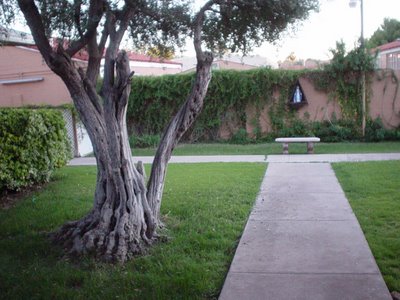A couple of times, I have heard or read complaints from individuals that the Catholic Church has become, or is in the process of becoming "feminized". Now while I sympathize in large part with the observations that might lead to this complaint, I feel the need to point something out.
Although it is a political hot-button, I imagine that most people take for granted that, generally, there are diverse virtues and aptitudes toward which men and women commonly gravitate. Even those feminists who are convinced that these differences have no 'essential' or 'natural' pedigree acknowledge that they exist (justly or not). Natural or not, just or not, the significance of these differences have been with us for so long that they have long penetrated deeply into the consciousness, not just of western society, but of humanity.
It's been the trend of Catholic magisterial teaching of the last century to celebrate those differences as revelatory of God's goodness and the magnificence of his creation. John Paul II made this explicit in his "Letter to Women":
"Womanhood and manhood are complementary not only from the physical and psychological points of view, but also from the ontological. It is only through the duality of the 'masculine' and the 'feminine' that the 'human' finds full realization."
John Paul there speaks of the "Genius of women" and the "feminine genius", and refers readers to Mulieris Dignitatem.
Now, to my point. Let's suppose for the sake of argument that there are distinctively 'feminine' and 'masculine' qualities, the former being traditionally associated with gentleness, kindness, receptivity/openness to others, understanding, motherliness, nurturing, morality, etc., and the latter being strength, courage, abstract intelligence, leadership, focus, industriousness, duty, honor, etc.
(Of course, I take for granted that any validity to this claim does not imply that these qualities are exclusive to one or the other sex, nor that they are the "property" thereof. The characterizations are ceteris paribus, or as far as the case may be).
Now, I think it's important to realize that we do not commonly criticize an individual for having an abundance of virtues 'associated' with a sex not his own. A man who has sufficient "manly" virtues, but is also gentle, kind, and receptive is not "effeminate" but, as C.S. Lewis would say, is rather "chivalrous". A woman who is not only understanding and motherly but also brilliant and industrious is not "butch" but heroic.
Anywhere a person tempts us to employ a pejorative, gender-associated word - effeminate, girly, catty, or pig, brute, and bully - it is scarcely because that person has too many virtues of the wrong kind, but rather that the person lacks the virtues that we would especially expect him or her to have on account of his/her sex.
I think this is an important distinction. If a man is called "effeminate," the implication is not that he has 'feminine' virtues, but that he is deficient in 'masculine' ones (he may be equally deficient in the feminine virtues). In this respect, the very word "effeminate" is misleading and inappropriate, as it falsely implies an inverse correlation between masculine and feminine virtues.
Some people may say at this stage that this is all good reason to drop all this talk of gender-associated virtues altogether. I disagree. I think that the last century has seen a good development in the rediscovery that the feminine embodies real virtues which need to be cultivated not only by women but by all human beings, and in this respect women will be more often the teachers of men than the reverse.
But a less positive development of the last century has been the widespread prejudice which has developed against the 'masculine' virtues, and the consequent elimination or neglect of them in parishes and Catholic discourse. And this is what I perceive when I hear people complain about the "feminization" of the Church. "Feminization" is not, properly speaking, a bad thing at all; done rightly, it turns barbarians into knights; it is the very stuff of civilization. The problem in the Church is not our fresh development of the collective muscles of kindness and gentleness, but rather the atrophy of virtues of duty, honor, courage, discipline, and the intellectual virtues. Thus I would not say that the Church has become wrongly "feminized", but I would say that it has become emasculated. Perhaps women and men both should mourn this loss.
Tuesday, November 28, 2006
Wednesday, November 22, 2006
In love with the 'she' of Catholicism
Sometimes my inner critic tells me that I seem to have a deeper fascination with the Catholic tradition than I do with the person of God, in Jesus, himself. Is my inner critic is the ghost of Karl Barth? I confess there is some legitimacy in the claim. Study is easier than prayer; as Blaise Pascal said, "Pious scholars are rare." When I do pray, I pray for deeper prayer; and I have never thought any description of the act more apropos than the Catechism's chapter title, "the battle of prayer."
But as regards my love for the tradition, I don't feel any particular guilt; and as I was developing a reason for this, I came up with a 'theory', though of course, nothing original, not even for myself.
As an entire way of being, Catholicism is radically and richly gendered. Of course, this did not begin with the dawn of Christianity, but has its roots in the Old Testament, in Wisdom literature, and perhaps might be counted as a basic anthropological fact. It is a feature arising from the fact that the most important human connections in life are personal ones, and we can scarcely have personal connections which are not also gendered.
Now, gender in the common sense is an inescapably bodily reality, and so the language of gender applied to spirit and to abstraction is always in some sense a concession to our mortal state. Incarnation and sacrament themselves are divine concessions, so Christian faith bestows a confidence that concessionary representations are not 'bad' things--not idolatrous or 'dumbed down' or 'corrupt' versions of the original, but rather testimonies to the stamp of ownership of the creator on every molecule of creation. Thus a single wave can contain the whole ocean. This is the mystery of Jesus Christ, than a single finite mortal man can 'contain' an infinite God.
So I conjecture that there is a legitimacy, and even a sort of divine seal of approval on the liberal application of gendered language not only for the person of God himself but also on every thing and every one divine or divinized, every gift given for our own sanctification. The consequence of such a notion is that the Catholic landscape, from the soaring heights of the liturgy and dogmatic theology to the daily drama of the domestic church, is everywhere bespeckled with he and she, everywhere interwoven with the and unitive-yet-preservative logic of Chalcedon.
Now, my being a male--and a male who grew up very close to a loving mother--is it really any wonder then that I have a special, even childish affection for the various 'shes' of Catholicism? Though I confess that I've never been well trained in Marian piety, Mary herself is linked by providence, analogy, and revelation to every 'she': the bride of the Song of Songs, holy Wisdom, the Law, mother Church, the woman clothed with the sun, and (what I will explain in a second) the female dimension of Christ himself.
Thus, to say that "Catholicism" or "the Tradition" or "doctrine" or "the Church" or "the saints" are not God, but rather are auxiliaries, helps, etc., that are not independent sources but rather reservoires of God's own grace, allowed to participate in God's self, makes me love all these things not less but more. As a Christian, I partake of the bride, and Christ is the bridegroom to whom "I" (not I individually, but I the bride) am sure to wed. As a man, I love the bride, and it is a love which tugs on the corporeal hooks of my sexed nature; again, a concession to my mortal state, but also an incarnation ordered toward divinization.
As regards the "female dimension of Christ," this bears some explaining. I am not particularly an advocate of female or androgynous crucifixes--which, like I complained about political art, have the depth of but a single idea; moreover, they offend against the particularity of the incarnation and have a gnostic disregard against the goodness and divine intention behind the sexed nature of the body.
That notwithstanding, as the second person of the Trinity, and in his loving obedience to the Father, Jesus has a (to use Von Balthasar's term) suprafeminine character. This character is accented, perhaps, by the patristic correlation of Christ with Holy Wisdom; and moreover St. Bernard of Clairvaux correlated Christ with the feminine 'beloved' in the Song of Songs.
I have to caution readers not to suppose that I am participating in the liberal project of feminizing Christ. Rather, what such points in the tradition reveal is that qualities commonly associated with 'femininity' (gentleness, receptivity, nurturing, etc.) were--and are--strongly present in the Godhead, and for that reason need to be strongly present in ourselves, even as males, if we are to receive the Grace necessary for salvation. Are we not each, individually as well as communally, desiring to give birth to Christ in our good works?
But I've strayed from the point. To be a Catholic, and thus to belong wholly to God, and yet to have a special passion for the Tradition or the Church, is not necessarily to participate in an "ecclesiolatry." It may be--particularly for males--a particular expression of a love for the Bride, the Mother, and thus in its own way an imitation of Christ.
But as regards my love for the tradition, I don't feel any particular guilt; and as I was developing a reason for this, I came up with a 'theory', though of course, nothing original, not even for myself.
As an entire way of being, Catholicism is radically and richly gendered. Of course, this did not begin with the dawn of Christianity, but has its roots in the Old Testament, in Wisdom literature, and perhaps might be counted as a basic anthropological fact. It is a feature arising from the fact that the most important human connections in life are personal ones, and we can scarcely have personal connections which are not also gendered.
Now, gender in the common sense is an inescapably bodily reality, and so the language of gender applied to spirit and to abstraction is always in some sense a concession to our mortal state. Incarnation and sacrament themselves are divine concessions, so Christian faith bestows a confidence that concessionary representations are not 'bad' things--not idolatrous or 'dumbed down' or 'corrupt' versions of the original, but rather testimonies to the stamp of ownership of the creator on every molecule of creation. Thus a single wave can contain the whole ocean. This is the mystery of Jesus Christ, than a single finite mortal man can 'contain' an infinite God.
So I conjecture that there is a legitimacy, and even a sort of divine seal of approval on the liberal application of gendered language not only for the person of God himself but also on every thing and every one divine or divinized, every gift given for our own sanctification. The consequence of such a notion is that the Catholic landscape, from the soaring heights of the liturgy and dogmatic theology to the daily drama of the domestic church, is everywhere bespeckled with he and she, everywhere interwoven with the and unitive-yet-preservative logic of Chalcedon.
Now, my being a male--and a male who grew up very close to a loving mother--is it really any wonder then that I have a special, even childish affection for the various 'shes' of Catholicism? Though I confess that I've never been well trained in Marian piety, Mary herself is linked by providence, analogy, and revelation to every 'she': the bride of the Song of Songs, holy Wisdom, the Law, mother Church, the woman clothed with the sun, and (what I will explain in a second) the female dimension of Christ himself.
Thus, to say that "Catholicism" or "the Tradition" or "doctrine" or "the Church" or "the saints" are not God, but rather are auxiliaries, helps, etc., that are not independent sources but rather reservoires of God's own grace, allowed to participate in God's self, makes me love all these things not less but more. As a Christian, I partake of the bride, and Christ is the bridegroom to whom "I" (not I individually, but I the bride) am sure to wed. As a man, I love the bride, and it is a love which tugs on the corporeal hooks of my sexed nature; again, a concession to my mortal state, but also an incarnation ordered toward divinization.
As regards the "female dimension of Christ," this bears some explaining. I am not particularly an advocate of female or androgynous crucifixes--which, like I complained about political art, have the depth of but a single idea; moreover, they offend against the particularity of the incarnation and have a gnostic disregard against the goodness and divine intention behind the sexed nature of the body.
That notwithstanding, as the second person of the Trinity, and in his loving obedience to the Father, Jesus has a (to use Von Balthasar's term) suprafeminine character. This character is accented, perhaps, by the patristic correlation of Christ with Holy Wisdom; and moreover St. Bernard of Clairvaux correlated Christ with the feminine 'beloved' in the Song of Songs.
I have to caution readers not to suppose that I am participating in the liberal project of feminizing Christ. Rather, what such points in the tradition reveal is that qualities commonly associated with 'femininity' (gentleness, receptivity, nurturing, etc.) were--and are--strongly present in the Godhead, and for that reason need to be strongly present in ourselves, even as males, if we are to receive the Grace necessary for salvation. Are we not each, individually as well as communally, desiring to give birth to Christ in our good works?
But I've strayed from the point. To be a Catholic, and thus to belong wholly to God, and yet to have a special passion for the Tradition or the Church, is not necessarily to participate in an "ecclesiolatry." It may be--particularly for males--a particular expression of a love for the Bride, the Mother, and thus in its own way an imitation of Christ.
Monday, November 20, 2006
Atheism coming back into vogue?
I don't know if it's me or not, but lately, atheism seems to be grabbing a bit more of the spotlight for itself in the media. Richard Dawkins has his new book out, The God Delusion, and he was recently on NPR. Internet forums, though still populated by a majority of "agnostics", seem to be developing a more hardcore, evangelical atheistic strain. Other atheists are being featured in the news more frequently, like Elton John. Just today I turned on my favorite rock station to hear a new hit song which was nothing but a declaration of atheism.
I guess that this might be a worrisome trend, but I can't say that it's a surprise. It isn't that any new discoveries have happened or that any stunning new arguments have developed; it's simply reactionary, though it is also a predictable consequence of the over-saturation of secularism which has crammed virtually every pore of daily American life.
A life in which God is not necessary. This is the secularist American dream--to attach oneself to the company of friends and the consolations of experience as, if not a kind of salvation, then an especially comfortable despair. The indulgence of a last meal before the inevitable execution, filled with increasingly more delicate and rare delights, more powerful drinks, hotter peppers, more decadent greases, cleverer and more enjoyable companions. Dead man walking? Dead man eating.
This is not to say that such involves any more a complacency toward world evils than is the temptation of the religious sort. Liberals and atheists do have a sort of monopoly on the claim to care about the world. It's the Marxist critique all over again--the poor sods only have this life to live. Not only I, but everybody has the right to as much of a "last meal" as I do. We're all going to die, it's the worst form of inequality that most are not offered a cigarette.
I suppose it's understandable that the push for civil rights and world amnesty would develop more of a pathos within the atheist framework. Meaningless pleasures; meaningless sufferings; if all is meaningless, then the difference between pleasure and suffering itself the last measurable hill to die on. It's a mistake to suppose that it is a one-way track from atheism to nihilism; there is a far more tolerable detour, from atheism to phenomenology to hedonism, then through cynicism to nihilism. The one who is only interested in his own stomach is in some sense more advanced than the moralistic Marxist; he has learned the vanity of utopian dreams.
But human civilization has Alzheimer's; lessons learned become passe and bourgeois, and we imagine that what was really wrong with the old totalitarian ideologies was only just a small thing, and we can do better than they did at the same project. Let us ban silly religion; those who find themselves unable to "live for the day" are simply morose and can be safely institutionalized.
I can't help but feel that there is a kind of malaise which is now blanketing the earth; just as the universe is growing further apart and colder, so now the human race's very energy is winding down. Immediacy is the watchword; the only salvation I desire is the one I have to walk the least distance to acquire. And there is no distance greater than the cross for the one who has no hope.
I guess that this might be a worrisome trend, but I can't say that it's a surprise. It isn't that any new discoveries have happened or that any stunning new arguments have developed; it's simply reactionary, though it is also a predictable consequence of the over-saturation of secularism which has crammed virtually every pore of daily American life.
A life in which God is not necessary. This is the secularist American dream--to attach oneself to the company of friends and the consolations of experience as, if not a kind of salvation, then an especially comfortable despair. The indulgence of a last meal before the inevitable execution, filled with increasingly more delicate and rare delights, more powerful drinks, hotter peppers, more decadent greases, cleverer and more enjoyable companions. Dead man walking? Dead man eating.
This is not to say that such involves any more a complacency toward world evils than is the temptation of the religious sort. Liberals and atheists do have a sort of monopoly on the claim to care about the world. It's the Marxist critique all over again--the poor sods only have this life to live. Not only I, but everybody has the right to as much of a "last meal" as I do. We're all going to die, it's the worst form of inequality that most are not offered a cigarette.
I suppose it's understandable that the push for civil rights and world amnesty would develop more of a pathos within the atheist framework. Meaningless pleasures; meaningless sufferings; if all is meaningless, then the difference between pleasure and suffering itself the last measurable hill to die on. It's a mistake to suppose that it is a one-way track from atheism to nihilism; there is a far more tolerable detour, from atheism to phenomenology to hedonism, then through cynicism to nihilism. The one who is only interested in his own stomach is in some sense more advanced than the moralistic Marxist; he has learned the vanity of utopian dreams.
But human civilization has Alzheimer's; lessons learned become passe and bourgeois, and we imagine that what was really wrong with the old totalitarian ideologies was only just a small thing, and we can do better than they did at the same project. Let us ban silly religion; those who find themselves unable to "live for the day" are simply morose and can be safely institutionalized.
I can't help but feel that there is a kind of malaise which is now blanketing the earth; just as the universe is growing further apart and colder, so now the human race's very energy is winding down. Immediacy is the watchword; the only salvation I desire is the one I have to walk the least distance to acquire. And there is no distance greater than the cross for the one who has no hope.
Thursday, November 16, 2006
Amatuer Photography Marathon III: Not For Sale
For our photography field trip, we visited St. Philip's Plaza, a ritzy corner of the north part of Tucson, full of art galleries, antique shop(pe)s, and expensive restaurants. Being the contrarian than I am, I didn't photograph any merchandise. My first goal was to stay away from the premeditated, structured, commercial reality set up to impress, and tried to capture the hidden, mundane, ugly, or plain realities of the plaza that marked it as a locale on the mortal plane of existence. I changed directions after a while, but here are the photos that follow that theme.
 The street out front of the plaza was heavily under construction. I like juxtaposing contrary elements--here the beautifully designed sign above mounds of broken concrete. A couple other examples:
The street out front of the plaza was heavily under construction. I like juxtaposing contrary elements--here the beautifully designed sign above mounds of broken concrete. A couple other examples:

I walked into a store, and saw these tucked away just inside an "employees only" room. I snuck in and snapped 'em. One of these things is not like the other...
 All right, so this is not a very interesting photo. But it follows my juxtaposition theme, and the effect is heightened by the dark-light-dark-light effect of the sunset.
All right, so this is not a very interesting photo. But it follows my juxtaposition theme, and the effect is heightened by the dark-light-dark-light effect of the sunset.
Some other distinctively "not for sale" stuff I shot:
 I'm going to sell this to the Arrowhead marketing department. I'll make MILLIONS.
I'm going to sell this to the Arrowhead marketing department. I'll make MILLIONS.
 What? I was thirsty. Could be featured in an Arrowhead water fountain user manual.
What? I was thirsty. Could be featured in an Arrowhead water fountain user manual.
Note I cheated on this one: I erased a blemish on my left hand. You can see artifacts from my editing. I'm still not very good with the GIMP.
 Besides being one of my favorite photos, this one allowed me to put my empty cup to good use. Waste not, want not.
Besides being one of my favorite photos, this one allowed me to put my empty cup to good use. Waste not, want not.
 As you can see, my reflection is perfectly visible in the nozzle. ARGHARGHARGHAR. I wonder if I could edit myself out.
As you can see, my reflection is perfectly visible in the nozzle. ARGHARGHARGHAR. I wonder if I could edit myself out.
 Looks more like police evidence than an artistic shot. Much of the concrete in the patios was covered in faint patterns like this. Intentional, or left over from sloppy construction workers? Guessing the latter, I shot it, and hiked up the contrast.
Looks more like police evidence than an artistic shot. Much of the concrete in the patios was covered in faint patterns like this. Intentional, or left over from sloppy construction workers? Guessing the latter, I shot it, and hiked up the contrast.
 If you're a dog, I'm sorry.
If you're a dog, I'm sorry.
 Now I won't be too offended if you say that my work is garbage. You can say anything you like, really. I've bin insulted worse than that. And I don't even care if my work is getting a little rusty. So should I put a lid on this paragraph? Maybe I'm just wasting my time. But would couple more throw-away lines hurt that much?
Now I won't be too offended if you say that my work is garbage. You can say anything you like, really. I've bin insulted worse than that. And I don't even care if my work is getting a little rusty. So should I put a lid on this paragraph? Maybe I'm just wasting my time. But would couple more throw-away lines hurt that much?
 Ah, such secrets as await us in the back-alleys of art galleries.
Ah, such secrets as await us in the back-alleys of art galleries.
 Imagine the looks I got photographing this instead of the thousand-dollar pots and sculptures with which I was surrounded. Really, do you think they would have made better photographs? But that is the postmodern nature of photography: the camera lens flattens the value of its objects--gold and dross are the same.
Imagine the looks I got photographing this instead of the thousand-dollar pots and sculptures with which I was surrounded. Really, do you think they would have made better photographs? But that is the postmodern nature of photography: the camera lens flattens the value of its objects--gold and dross are the same.
 I might try rendering this as black and white eventually... but not the proceeding one:
I might try rendering this as black and white eventually... but not the proceeding one:
 Waves in a sea of clay.
Waves in a sea of clay.
NOW, as I said, I didn't just photograph junk and utilitarian objects. I still stayed away from merchandise, but it's impossible to be in a place like this and avoid everything beautiful.

 Sometimes I feel it's a shame shadows are associated with the concept of an 'insubstantial copy'. The substance of a shadow is that it is cast by a light, through an object, onto a surface. A shadow has a substance, and that substance is relationality. To wit:
Sometimes I feel it's a shame shadows are associated with the concept of an 'insubstantial copy'. The substance of a shadow is that it is cast by a light, through an object, onto a surface. A shadow has a substance, and that substance is relationality. To wit:

More pretty things...



 ...what?
...what?
 My camera (formerly yours, Br. Thomas, if you're reading this) has no zoom lens. That means, yes, I was standing knee deep in freezing cold water. Our instructor was so amused, she snapped me in the act--I will post it if I get a copy.
My camera (formerly yours, Br. Thomas, if you're reading this) has no zoom lens. That means, yes, I was standing knee deep in freezing cold water. Our instructor was so amused, she snapped me in the act--I will post it if I get a copy.
 Just so you know, that water was really cold.
Just so you know, that water was really cold.

 Off of the gate entering the courtyard of St. Phillip in the Hills Episcopal Church (twice as beautiful as any Catholic Churches in the city. Those silly Episcopalians, didn't they learn anything from the iconoclastic architecture of the 70's? Art's not supposed to imitate nature!)
Off of the gate entering the courtyard of St. Phillip in the Hills Episcopal Church (twice as beautiful as any Catholic Churches in the city. Those silly Episcopalians, didn't they learn anything from the iconoclastic architecture of the 70's? Art's not supposed to imitate nature!)
Note the difference between the above two artistic flowers, and fake flowers. Artistic imitation is not pretend. Imitation glorifies that which it imitates; pretend insults that whose visage it steals.
 The courtyard itself. It's late in the day at this point, so my light's not very good.
The courtyard itself. It's late in the day at this point, so my light's not very good.
One last beauty before I go to sleep.

 The street out front of the plaza was heavily under construction. I like juxtaposing contrary elements--here the beautifully designed sign above mounds of broken concrete. A couple other examples:
The street out front of the plaza was heavily under construction. I like juxtaposing contrary elements--here the beautifully designed sign above mounds of broken concrete. A couple other examples:
I walked into a store, and saw these tucked away just inside an "employees only" room. I snuck in and snapped 'em. One of these things is not like the other...
 All right, so this is not a very interesting photo. But it follows my juxtaposition theme, and the effect is heightened by the dark-light-dark-light effect of the sunset.
All right, so this is not a very interesting photo. But it follows my juxtaposition theme, and the effect is heightened by the dark-light-dark-light effect of the sunset.Some other distinctively "not for sale" stuff I shot:
 I'm going to sell this to the Arrowhead marketing department. I'll make MILLIONS.
I'm going to sell this to the Arrowhead marketing department. I'll make MILLIONS. What? I was thirsty. Could be featured in an Arrowhead water fountain user manual.
What? I was thirsty. Could be featured in an Arrowhead water fountain user manual.Note I cheated on this one: I erased a blemish on my left hand. You can see artifacts from my editing. I'm still not very good with the GIMP.
 Besides being one of my favorite photos, this one allowed me to put my empty cup to good use. Waste not, want not.
Besides being one of my favorite photos, this one allowed me to put my empty cup to good use. Waste not, want not. As you can see, my reflection is perfectly visible in the nozzle. ARGHARGHARGHAR. I wonder if I could edit myself out.
As you can see, my reflection is perfectly visible in the nozzle. ARGHARGHARGHAR. I wonder if I could edit myself out. Looks more like police evidence than an artistic shot. Much of the concrete in the patios was covered in faint patterns like this. Intentional, or left over from sloppy construction workers? Guessing the latter, I shot it, and hiked up the contrast.
Looks more like police evidence than an artistic shot. Much of the concrete in the patios was covered in faint patterns like this. Intentional, or left over from sloppy construction workers? Guessing the latter, I shot it, and hiked up the contrast. If you're a dog, I'm sorry.
If you're a dog, I'm sorry. Now I won't be too offended if you say that my work is garbage. You can say anything you like, really. I've bin insulted worse than that. And I don't even care if my work is getting a little rusty. So should I put a lid on this paragraph? Maybe I'm just wasting my time. But would couple more throw-away lines hurt that much?
Now I won't be too offended if you say that my work is garbage. You can say anything you like, really. I've bin insulted worse than that. And I don't even care if my work is getting a little rusty. So should I put a lid on this paragraph? Maybe I'm just wasting my time. But would couple more throw-away lines hurt that much? Ah, such secrets as await us in the back-alleys of art galleries.
Ah, such secrets as await us in the back-alleys of art galleries. Imagine the looks I got photographing this instead of the thousand-dollar pots and sculptures with which I was surrounded. Really, do you think they would have made better photographs? But that is the postmodern nature of photography: the camera lens flattens the value of its objects--gold and dross are the same.
Imagine the looks I got photographing this instead of the thousand-dollar pots and sculptures with which I was surrounded. Really, do you think they would have made better photographs? But that is the postmodern nature of photography: the camera lens flattens the value of its objects--gold and dross are the same. I might try rendering this as black and white eventually... but not the proceeding one:
I might try rendering this as black and white eventually... but not the proceeding one: Waves in a sea of clay.
Waves in a sea of clay.NOW, as I said, I didn't just photograph junk and utilitarian objects. I still stayed away from merchandise, but it's impossible to be in a place like this and avoid everything beautiful.

 Sometimes I feel it's a shame shadows are associated with the concept of an 'insubstantial copy'. The substance of a shadow is that it is cast by a light, through an object, onto a surface. A shadow has a substance, and that substance is relationality. To wit:
Sometimes I feel it's a shame shadows are associated with the concept of an 'insubstantial copy'. The substance of a shadow is that it is cast by a light, through an object, onto a surface. A shadow has a substance, and that substance is relationality. To wit:
More pretty things...



 ...what?
...what? My camera (formerly yours, Br. Thomas, if you're reading this) has no zoom lens. That means, yes, I was standing knee deep in freezing cold water. Our instructor was so amused, she snapped me in the act--I will post it if I get a copy.
My camera (formerly yours, Br. Thomas, if you're reading this) has no zoom lens. That means, yes, I was standing knee deep in freezing cold water. Our instructor was so amused, she snapped me in the act--I will post it if I get a copy. Just so you know, that water was really cold.
Just so you know, that water was really cold. Off of the gate entering the courtyard of St. Phillip in the Hills Episcopal Church (twice as beautiful as any Catholic Churches in the city. Those silly Episcopalians, didn't they learn anything from the iconoclastic architecture of the 70's? Art's not supposed to imitate nature!)
Off of the gate entering the courtyard of St. Phillip in the Hills Episcopal Church (twice as beautiful as any Catholic Churches in the city. Those silly Episcopalians, didn't they learn anything from the iconoclastic architecture of the 70's? Art's not supposed to imitate nature!)Note the difference between the above two artistic flowers, and fake flowers. Artistic imitation is not pretend. Imitation glorifies that which it imitates; pretend insults that whose visage it steals.
 The courtyard itself. It's late in the day at this point, so my light's not very good.
The courtyard itself. It's late in the day at this point, so my light's not very good.One last beauty before I go to sleep.

Amatuer Photography Marathon II: The Roses
Wild roses grow surprisingly well in the desert. I shot these on a whim as I was getting into my car to go to photography lessons.
 Sadly, this one was already on its way out.
Sadly, this one was already on its way out.
 This one, however, was fresh and beautiful. I took shots from about five different angles. The above isn't terrible. Sadly I couldn't do anything about the fence, so I tried to make it work for me rather than against me. The worst thing about the shot that I can see is where the pedals overlap the concrete and force the flower to compete with it.
This one, however, was fresh and beautiful. I took shots from about five different angles. The above isn't terrible. Sadly I couldn't do anything about the fence, so I tried to make it work for me rather than against me. The worst thing about the shot that I can see is where the pedals overlap the concrete and force the flower to compete with it.
 Ah, she is liberated!
Ah, she is liberated!
 Funny thing about love is that it brings us to wish to wrap ourselves in the beloved, to allow it to encompass everything we know of the world.
Funny thing about love is that it brings us to wish to wrap ourselves in the beloved, to allow it to encompass everything we know of the world.

 Sadly, this one was already on its way out.
Sadly, this one was already on its way out. This one, however, was fresh and beautiful. I took shots from about five different angles. The above isn't terrible. Sadly I couldn't do anything about the fence, so I tried to make it work for me rather than against me. The worst thing about the shot that I can see is where the pedals overlap the concrete and force the flower to compete with it.
This one, however, was fresh and beautiful. I took shots from about five different angles. The above isn't terrible. Sadly I couldn't do anything about the fence, so I tried to make it work for me rather than against me. The worst thing about the shot that I can see is where the pedals overlap the concrete and force the flower to compete with it. Ah, she is liberated!
Ah, she is liberated! Funny thing about love is that it brings us to wish to wrap ourselves in the beloved, to allow it to encompass everything we know of the world.
Funny thing about love is that it brings us to wish to wrap ourselves in the beloved, to allow it to encompass everything we know of the world.
Amatuer Photography Marathon I: The Tree

Once upon a time, the parish offices of the church I am at were a convent, and this courtyard looked very different--but the tree is still there. Old trees are witnesses of forgotten days. I wanted this tree to tell me its secrets.
 The sky here is a problem. It should be blue. But nevermind that.
The sky here is a problem. It should be blue. But nevermind that. The class assignment I had in mind while taking these photos was to try and capture "patterns and textures", and my friend here delivered in abundance. I sort of wish the lighting were more dramatic here, though.
The class assignment I had in mind while taking these photos was to try and capture "patterns and textures", and my friend here delivered in abundance. I sort of wish the lighting were more dramatic here, though.
Do you see the owl? I loved how the lines trickled down through the bark into the ground. The "owl" is a bonus that I wasn't even thinking of when I took the shot. If it were hand-carved, it would have been very reminiscent of the art of Stephen Gammel, who illustrated the "Scary Stories to Tell in the Dark" books.

 I should have played with the focus to get a better shot of Mary, but I wasn't thinking about it, and her blurriness wasn't apparent in the viewfinder. The different color of the tree is due to my switching the white balance to "sunlight", whereas before it was set to incandescent light (which corrects against incandescent lights' yellow tinge).
I should have played with the focus to get a better shot of Mary, but I wasn't thinking about it, and her blurriness wasn't apparent in the viewfinder. The different color of the tree is due to my switching the white balance to "sunlight", whereas before it was set to incandescent light (which corrects against incandescent lights' yellow tinge).
I like this one better, actually; unfortunately, the hot light on the side of the tree distracts from the real subject: the sprouts growing from the severed limb. Also, LOOK, the sky is BLUE.

The instructor liked this one because the trunks all lead your attention to the same place. I don't like it because your attention is being led to... what? Nothing. But a decently composed photo. Stupid hose in the corner.
Tuesday, November 14, 2006
About my brain.
I lied in my last post. I was exhausted, but I didn't go to sleep; I went to the cafe and had a decaf mocha with cream. No caffeine, perhaps, but the SUGAR is making me CRAZY.
So as I was walking home, I was thinking about thinking, and thinking about thinking about thinking. Thought thinking itself thinking itself. And my mind got on the subject of how my thought has certain distinguishing characteristics in its movement.
Now, I have been irritated in the past by people talking about how they think in a "special" way that made them see things other people didn't see. Maybe I can distance myself from that by stating that I simply fall on the "N" side of the Myers-Briggs spectrum. I claim no magic powers.
There is a kind of obvious analogy of how N's think that captures the strengths and weaknesses of the style: data compression in computers. Specifically, images.
A picture requires a lot of "space" in a computer. A bitmap image (your basic, non-compressed, Windows image) has to record the color of each of the pixels inside of it individually, no shortcuts.
A compressed image, like a GIF, uses the same "space" (on the hard drive or the memory) to record the color of multiple pixels, so long as they have the same color. This saves space automatically, but GIFs can save even more if they fudge the colors a little to make even more pixels fit into the same space.
A JPEG image works a little differently--and I haven't studied the JPEG algorithm so this may be inaccurate. But I believe a JPEG not only stores the same colors of individual pixels into the same space; but it looks for patterns of strings of colors, and reuses the same space to contain any number of patterns that look similar to each other. Converting a file to a JPEG usually involves selecting a degree of compression, which means that you can tell the software how much or how little you want it to prefer its patterns or the original image's actual data. Turning up the compression can put ginormous images into a little bit of space; but those images will, depending on their complexity, wind up looking like abstract art.
Just as a computer can compensate for a lack of hard-drive space by cramming multiple pieces of data into the same space, so also our minds take shortcuts in remembering.
All minds do this; some are more vigorous than others. Those are the 'N's.
If it's one thing my brain does well, it's analogies. This is why. If it's one thing my brain does not do well, it's remembering names. This is also why. The 'N' is the archetype of the absent-minded professor.
But there's one thing an 'N' brain can do that a computer cannot. Although JPEG compression works by storing similar patterns, the patterns themselves have no actual worth, and they wind up distorting rather than clarifying the picture. Yet the 'N' receives his intellectual paycheck precisely by constantly comparing disparate bits of being. Now, if you happen to believe that being is actually analogically structured in its essence, and not just in our minds, then this opens up all kinds of possibilities.
Of course, just as I pointed out a few posts ago, drawing broad comparisons is worthless if you fail first to make all the proper distinctions. But to recognize patterns is also to recognize differences between patterns--and it is to recognize patterns in the differences in the patterns.
Being an 'N', I think, is a prerequisite on some level for being a poet, or any respectable sort of artist whose work actually communicates meaning of value. But it is not enough. I am not an artist or a poet. There is something wonderfully incarnational about good art, wherein a single work is able to embody a pattern which can--because it is a pattern--explode into a myriad of concrete meanings. I am not referring to "avant garde" abstract art, which pretends to have infinite meaning precisely by having no meaning at all--da-da art that is embarrassed at its own da-da-ness. Nor do I much respect political art, which to its credit does have meaning, but it is only one meaning; as deep as a stop sign.
But (and here is where I falter because I have to do research to find individual concrete examples--blah)... consider the multi-layered and richly symbolic works of Hieronymus Basch, or the subject-object meshing of Van Gogh, the delight and fear of nature's orderliness evident in JS Bach's music, or the oscillating faith and doubt in the cult of romanticism by John Keats.
Whew. That tuckered me out. But I guess what I am trying to say is that the true artist is "ambidextrous" in a sense--intuitive enough for creative genius and sensate enough to actually create. The philosophers and theologians of the world (aspiring and experienced alike) are, sadly, frustrated artists.
So as I was walking home, I was thinking about thinking, and thinking about thinking about thinking. Thought thinking itself thinking itself. And my mind got on the subject of how my thought has certain distinguishing characteristics in its movement.
Now, I have been irritated in the past by people talking about how they think in a "special" way that made them see things other people didn't see. Maybe I can distance myself from that by stating that I simply fall on the "N" side of the Myers-Briggs spectrum. I claim no magic powers.
There is a kind of obvious analogy of how N's think that captures the strengths and weaknesses of the style: data compression in computers. Specifically, images.
A picture requires a lot of "space" in a computer. A bitmap image (your basic, non-compressed, Windows image) has to record the color of each of the pixels inside of it individually, no shortcuts.
A compressed image, like a GIF, uses the same "space" (on the hard drive or the memory) to record the color of multiple pixels, so long as they have the same color. This saves space automatically, but GIFs can save even more if they fudge the colors a little to make even more pixels fit into the same space.
A JPEG image works a little differently--and I haven't studied the JPEG algorithm so this may be inaccurate. But I believe a JPEG not only stores the same colors of individual pixels into the same space; but it looks for patterns of strings of colors, and reuses the same space to contain any number of patterns that look similar to each other. Converting a file to a JPEG usually involves selecting a degree of compression, which means that you can tell the software how much or how little you want it to prefer its patterns or the original image's actual data. Turning up the compression can put ginormous images into a little bit of space; but those images will, depending on their complexity, wind up looking like abstract art.
Just as a computer can compensate for a lack of hard-drive space by cramming multiple pieces of data into the same space, so also our minds take shortcuts in remembering.
All minds do this; some are more vigorous than others. Those are the 'N's.
If it's one thing my brain does well, it's analogies. This is why. If it's one thing my brain does not do well, it's remembering names. This is also why. The 'N' is the archetype of the absent-minded professor.
But there's one thing an 'N' brain can do that a computer cannot. Although JPEG compression works by storing similar patterns, the patterns themselves have no actual worth, and they wind up distorting rather than clarifying the picture. Yet the 'N' receives his intellectual paycheck precisely by constantly comparing disparate bits of being. Now, if you happen to believe that being is actually analogically structured in its essence, and not just in our minds, then this opens up all kinds of possibilities.
Of course, just as I pointed out a few posts ago, drawing broad comparisons is worthless if you fail first to make all the proper distinctions. But to recognize patterns is also to recognize differences between patterns--and it is to recognize patterns in the differences in the patterns.
Being an 'N', I think, is a prerequisite on some level for being a poet, or any respectable sort of artist whose work actually communicates meaning of value. But it is not enough. I am not an artist or a poet. There is something wonderfully incarnational about good art, wherein a single work is able to embody a pattern which can--because it is a pattern--explode into a myriad of concrete meanings. I am not referring to "avant garde" abstract art, which pretends to have infinite meaning precisely by having no meaning at all--da-da art that is embarrassed at its own da-da-ness. Nor do I much respect political art, which to its credit does have meaning, but it is only one meaning; as deep as a stop sign.
But (and here is where I falter because I have to do research to find individual concrete examples--blah)... consider the multi-layered and richly symbolic works of Hieronymus Basch, or the subject-object meshing of Van Gogh, the delight and fear of nature's orderliness evident in JS Bach's music, or the oscillating faith and doubt in the cult of romanticism by John Keats.
Whew. That tuckered me out. But I guess what I am trying to say is that the true artist is "ambidextrous" in a sense--intuitive enough for creative genius and sensate enough to actually create. The philosophers and theologians of the world (aspiring and experienced alike) are, sadly, frustrated artists.
A first religious ed lesson for teens.
(Note: DO NOT copy and paste text from OpenOffice into Blogger. It makes Firefox crash and all your work go byebye).
I had to substitute for a class tonight, so I pulled together some things very quickly. However, the night went so well, I thought I would document what happened.
Handouts:
After taking attendance, I passed out the sheet with the scripture passages, and we prayed Jeremiah as our opening prayer. In the introduction to the prayer, I ask for a full minute of silence after the prayer. 60 seconds go by, and (hopefully) somebody messes up by giggling or making a comment or some such nonsense.
The first words out of my mouth are: "So. Why did you fail?" One or two students explain, "I laughed!" or "He made me laugh!" I counter, "I didn't ask how you failed. I asked why."
I am trying to get the kids to think about why silence is uncomfortable for them. "There are 1, 440 minutes in a day. Why do you insist that each one be filled with noise?"
After some batting about of different answers, one precocious girl raised her hand and said, "Well, dead people are silent, but we're alive, so we want to make noise while we can." Brilliant!
I ask, "So do you think that by talking more you can postpone death?" (I get some 'hms').
Another guy (who is very talkative) says, "I like to express myself. I'm very expressive." I respond, "So why do you feel you're the one who always needs to be expressed?"
He says, "I don't like to keep things bottled up inside." I respond, "It's a good thing you're not afraid to let yourself be known. But we should remember that when our mouths are open, our ears are closed."
"When we make noise, we fill our world with ourselves, and we create a comfort zone. It is less comfortable to listen because then we have to share our space with somebody else's words. But even others' words are better than silence, because in silence we hear nothing, and we discover that we are small in a world of emptiness."
I pass out the news stories, making some students share because I didn't have enough stories for each one. I give 'em about five minutes to go through the news articles, and then I interview each one about what their story said (no play-acting. Just me). Each student tells reports--suicide bombings, kidnappings, murder, abortion deaths, all by the hundreds and the thousands and the tens of thousands--and most of the stories were from that very day.
After a little discussion about current events, I ask, "Who here has spent more than $25 in the last week?" About half the hands go up. "See, now, if I were a guy who worked for a company like McDonalds or Dillards or Spencers, I would be looking at you right now and I wouldn't see teenagers, you know, with dreams and futures and stories and real lives. Instead, I see wallets." (some giggles). "Big, FAT wallets."
"And I know that if I want to get into those wallets, I have to decorate your world to make you believe that my things are what's important in life. I have to make noise."
"Tell me, how many of you think about the stuff in the news articles I gave you?" (A couple hands) "Every day?" (one hand) "And it drives you to tears?" (No hands). "'Let my eyes stream with tears, day and night, without rest, over the destruction that overwhelms the virgin daughter of my people.'"
"Can I suggest that the reason we don't like silence, that we're afraid of a little silence, is because in silence we begin to remember that our noise is a happy illusion?" [Pause] "The world is groaning in pain. People are left in streets with gunshot wounds, begging for mercy, but the hospitals are full. 48 million corpses are torn from their mothers' wombs, with tiny little arms and tiny little feet, every single year, and thrown away like trash. And ourselves. We are afraid of death. We do not want to accept that death will finally claim us. So we make noise. It helps us forget. We are a people who love to forget."
... I'm kind of exhausted even from writing this. I'm going to sleep.
I had to substitute for a class tonight, so I pulled together some things very quickly. However, the night went so well, I thought I would document what happened.
Handouts:
- Sheet with Bible passages - Jeremiah 14:17-22 (let my eyes stream with tears), and 1 Corinthians 15:51-58 (O Death, is is your victory?).
- "Catholic Lists" (ten commandments, capital sins, etc., copied out of the back of the Opus Dei daily missal)
- A series of current events of bad things happening, found via Google news.
After taking attendance, I passed out the sheet with the scripture passages, and we prayed Jeremiah as our opening prayer. In the introduction to the prayer, I ask for a full minute of silence after the prayer. 60 seconds go by, and (hopefully) somebody messes up by giggling or making a comment or some such nonsense.
The first words out of my mouth are: "So. Why did you fail?" One or two students explain, "I laughed!" or "He made me laugh!" I counter, "I didn't ask how you failed. I asked why."
I am trying to get the kids to think about why silence is uncomfortable for them. "There are 1, 440 minutes in a day. Why do you insist that each one be filled with noise?"
After some batting about of different answers, one precocious girl raised her hand and said, "Well, dead people are silent, but we're alive, so we want to make noise while we can." Brilliant!
I ask, "So do you think that by talking more you can postpone death?" (I get some 'hms').
Another guy (who is very talkative) says, "I like to express myself. I'm very expressive." I respond, "So why do you feel you're the one who always needs to be expressed?"
He says, "I don't like to keep things bottled up inside." I respond, "It's a good thing you're not afraid to let yourself be known. But we should remember that when our mouths are open, our ears are closed."
"When we make noise, we fill our world with ourselves, and we create a comfort zone. It is less comfortable to listen because then we have to share our space with somebody else's words. But even others' words are better than silence, because in silence we hear nothing, and we discover that we are small in a world of emptiness."
I pass out the news stories, making some students share because I didn't have enough stories for each one. I give 'em about five minutes to go through the news articles, and then I interview each one about what their story said (no play-acting. Just me). Each student tells reports--suicide bombings, kidnappings, murder, abortion deaths, all by the hundreds and the thousands and the tens of thousands--and most of the stories were from that very day.
After a little discussion about current events, I ask, "Who here has spent more than $25 in the last week?" About half the hands go up. "See, now, if I were a guy who worked for a company like McDonalds or Dillards or Spencers, I would be looking at you right now and I wouldn't see teenagers, you know, with dreams and futures and stories and real lives. Instead, I see wallets." (some giggles). "Big, FAT wallets."
"And I know that if I want to get into those wallets, I have to decorate your world to make you believe that my things are what's important in life. I have to make noise."
"Tell me, how many of you think about the stuff in the news articles I gave you?" (A couple hands) "Every day?" (one hand) "And it drives you to tears?" (No hands). "'Let my eyes stream with tears, day and night, without rest, over the destruction that overwhelms the virgin daughter of my people.'"
"Can I suggest that the reason we don't like silence, that we're afraid of a little silence, is because in silence we begin to remember that our noise is a happy illusion?" [Pause] "The world is groaning in pain. People are left in streets with gunshot wounds, begging for mercy, but the hospitals are full. 48 million corpses are torn from their mothers' wombs, with tiny little arms and tiny little feet, every single year, and thrown away like trash. And ourselves. We are afraid of death. We do not want to accept that death will finally claim us. So we make noise. It helps us forget. We are a people who love to forget."
... I'm kind of exhausted even from writing this. I'm going to sleep.
Monday, November 13, 2006
On "participation"
It's amazing; with each caffeinated beverage I consume, I want to write another post!
I want to nuance my last post a little bit, since someone who didn't know any better might believe that I was simply bemoaning reductionism in disputes, and there is more to it. It's true that I think the main sin of spectrum-thinking and other like fallacies is one of oversimplification, and a failure to make proper distinctions. However, though making good distinctions is not the sole purpose of philosophy. We also have to subsume common elements into recognizable categories. Doubtless people can see me doing that when I try and get at the root of liberalism as a single phenomenon in the history of ideas. At least I make an attempt not to group disparate features capriciously.
The special problem of trying to form conceptual umbrellas under which to group disparate things is that these umbrellas will always be "extreme". For example, if I include under the heading of "liberal" the qualities of prioritizing the nominalist/modern scientific notion of knowledge, the flattening of values, and a mechanistic concept of the human body, my definition begins to differ little from the worst nihilistic atheist. It is a self-consciously stereotypical model; a banding together of characteristics which distinguish liberalism from its contraries, and thus allowing nothing of moderation in itself.
I don't believe that this is a bad practice, but it can get arguers into trouble. The most public recent example is the skirmish between Pope Benedict and radical Islam. Although the most violent reaction to his Regensburg speech was due to a misunderstanding, there was more moderate criticism of his speech from moderate and educated Muslims. At the core of this criticism is that Pope Benedict established a conceptual umbrella he called de-Hellenization, and under this category he assigned Protestant fundamentalism, and Islam--perhaps while failing to make proper distinctions as to the "Islam" he was speaking of.
I do not believe the Pope was wrong to make this argument. There is an iconoclastic strain in the history of ideas that pops up now and again, and seeks to rid religion of any pagan rationalizing. Moreover, that "dehellenizing" strain can be found prominently in the birth and spread of fundamentalist movements in several religions; Protestantism and Islam are two easily accessible examples.
What people probably missed was that the Pope was making use of a certain style of argument. I don't have a name for it. Maybe somebody does. But it goes like this: "See, there is this thing, X, and X is not very good, so we should avoid participating in X. Now see how these various things, A, B, and C, participate in X, and how this causes common problems we see in the world today."
The key word is participation. Whenever we construct a model or a category, under which we (rightly or wrongly) subsume various features, and then we make a comparison of that model to something concrete, we implicitly recognize that the model and the concrete thing aren't exactly the same. So when we say that A participates in X, we mean that A has features in common with X, and X is something we know about, so maybe X can tell us where A comes from, or is going to.
Using models and general concepts, and arguing based on them, is not a fallacy, but it is the stuff out of which so many fallacies are made: straw-men arguments, racism, stereotypes, and so on. I suggest that arguing from models and concepts falls into these fallacies when one of two things happen:
1. The concept itself is inadequate. The pieces of the concept have no essentially unifying quality, taking their apparent coherence instead from prejudice and groupthink. This is certainly the case with racism, but it is also the case with any provincial prejudices and irrational fears that nobody in this sin-torn world is ultimately free from.
2. The concept is adequate, but in the rhetoric of comparison, one fails to clarify that it is a model in which the concrete thing participates. Instead the model and the concrete fact are simply conflated, which leads to the accusation of stereotyping. An example. Suppose for the sake of argument that we take The Simpsons as an adequate model of a dysfunctional family. It would be one thing for a family counselor to draw comparisons between the actions of, say, the real father and the actions of Homer Simpson. "Do you remember that episode where Homer ...? Maybe you could learn from his mistake." It would be quite another for the counselor to say, "You, sir, are like Homer Simpson."
The thing about arguing based on general concepts, and using the language of "this participates in that", is that it incorporates both "black and white" thought and "spectrum thought". There are blacks and whites; there are models and concepts and discoveries that have some kind of reality, some stable inner coherence, such that they might even be simultaneously discovered by disparate peoples. But at the same time there is the fact that we never find any of these concepts in pure form within the concrete realm. So instead we say that A participates in X--and in saying so, we admit that this participation happens in varying degrees.
If anyone has observed that I have suddenly become very Platonic in my thought, then have a cookie.
I bring this out not to contradict my last post but to sort of bring it full circle. Yes, there is legitimate "binary thought" and "spectrum thought" but they never exist in isolation from the other and they do not excuse the preliminary task (that I emphasized in the previous post) of going through and making all the proper distinctions.
I want to nuance my last post a little bit, since someone who didn't know any better might believe that I was simply bemoaning reductionism in disputes, and there is more to it. It's true that I think the main sin of spectrum-thinking and other like fallacies is one of oversimplification, and a failure to make proper distinctions. However, though making good distinctions is not the sole purpose of philosophy. We also have to subsume common elements into recognizable categories. Doubtless people can see me doing that when I try and get at the root of liberalism as a single phenomenon in the history of ideas. At least I make an attempt not to group disparate features capriciously.
The special problem of trying to form conceptual umbrellas under which to group disparate things is that these umbrellas will always be "extreme". For example, if I include under the heading of "liberal" the qualities of prioritizing the nominalist/modern scientific notion of knowledge, the flattening of values, and a mechanistic concept of the human body, my definition begins to differ little from the worst nihilistic atheist. It is a self-consciously stereotypical model; a banding together of characteristics which distinguish liberalism from its contraries, and thus allowing nothing of moderation in itself.
I don't believe that this is a bad practice, but it can get arguers into trouble. The most public recent example is the skirmish between Pope Benedict and radical Islam. Although the most violent reaction to his Regensburg speech was due to a misunderstanding, there was more moderate criticism of his speech from moderate and educated Muslims. At the core of this criticism is that Pope Benedict established a conceptual umbrella he called de-Hellenization, and under this category he assigned Protestant fundamentalism, and Islam--perhaps while failing to make proper distinctions as to the "Islam" he was speaking of.
I do not believe the Pope was wrong to make this argument. There is an iconoclastic strain in the history of ideas that pops up now and again, and seeks to rid religion of any pagan rationalizing. Moreover, that "dehellenizing" strain can be found prominently in the birth and spread of fundamentalist movements in several religions; Protestantism and Islam are two easily accessible examples.
What people probably missed was that the Pope was making use of a certain style of argument. I don't have a name for it. Maybe somebody does. But it goes like this: "See, there is this thing, X, and X is not very good, so we should avoid participating in X. Now see how these various things, A, B, and C, participate in X, and how this causes common problems we see in the world today."
The key word is participation. Whenever we construct a model or a category, under which we (rightly or wrongly) subsume various features, and then we make a comparison of that model to something concrete, we implicitly recognize that the model and the concrete thing aren't exactly the same. So when we say that A participates in X, we mean that A has features in common with X, and X is something we know about, so maybe X can tell us where A comes from, or is going to.
Using models and general concepts, and arguing based on them, is not a fallacy, but it is the stuff out of which so many fallacies are made: straw-men arguments, racism, stereotypes, and so on. I suggest that arguing from models and concepts falls into these fallacies when one of two things happen:
1. The concept itself is inadequate. The pieces of the concept have no essentially unifying quality, taking their apparent coherence instead from prejudice and groupthink. This is certainly the case with racism, but it is also the case with any provincial prejudices and irrational fears that nobody in this sin-torn world is ultimately free from.
2. The concept is adequate, but in the rhetoric of comparison, one fails to clarify that it is a model in which the concrete thing participates. Instead the model and the concrete fact are simply conflated, which leads to the accusation of stereotyping. An example. Suppose for the sake of argument that we take The Simpsons as an adequate model of a dysfunctional family. It would be one thing for a family counselor to draw comparisons between the actions of, say, the real father and the actions of Homer Simpson. "Do you remember that episode where Homer ...? Maybe you could learn from his mistake." It would be quite another for the counselor to say, "You, sir, are like Homer Simpson."
The thing about arguing based on general concepts, and using the language of "this participates in that", is that it incorporates both "black and white" thought and "spectrum thought". There are blacks and whites; there are models and concepts and discoveries that have some kind of reality, some stable inner coherence, such that they might even be simultaneously discovered by disparate peoples. But at the same time there is the fact that we never find any of these concepts in pure form within the concrete realm. So instead we say that A participates in X--and in saying so, we admit that this participation happens in varying degrees.
If anyone has observed that I have suddenly become very Platonic in my thought, then have a cookie.
I bring this out not to contradict my last post but to sort of bring it full circle. Yes, there is legitimate "binary thought" and "spectrum thought" but they never exist in isolation from the other and they do not excuse the preliminary task (that I emphasized in the previous post) of going through and making all the proper distinctions.
Some more points on controversies in general.
My understanding of, and relationship to Catholic faith was forged in large part out of controversy. Whatever drawbacks that may entail--and there are some pernicious ones--one of the benefits is that it has taught me some lessons about controversy itself.
I have written before about the problem of what I call "spectrum thinking." Basically it is the liberal correlate to what they themselves accuse conservatives of, i.e., "black and white thinking." The supposition that the intellectual sins of binary thought can be healed with the universal salve of thinking in "shades of gray" strikes me as futile and misologist, for several reasons.
First, the entire science of logic itself, which I hope has not been entirely rejected as a criterion of valid argument, is founded not on impressionistic grays but on a complex multitude of binaries. It is an irony of the advocacy of "shades of gray" that it purports to recognize the complexity of life--when in fact, complexity is done infinitely more justice by the acknowledgment of irreducible difference implicit in the analogy of "black and white," than by the disavowal of difference implicit in suggesting that they are always part of the same spectrum. Thus it is not surprising that the spirit of spectrum thinking, thought it postures as the "open minded" option, at the same time effectively works to obstruct dialogue on matters of truth, moved as it is by the fear that should anything be discovered true, its contradictories would then be judged false. The horror!
Second, spectrum thinking never actually transcends binary thought; it only has different opinions about which activities are "white" and which ones are "black". If the ideal of spectrum thinking is the pious advocacy of multiplicity in thought, then this remains nevertheless a single ideal, which will nevertheless compete with other ideals incompatible with itself.
Third, and this is the big one, spectrum thinking creates an artificial relationship between the two "ends" of the spectrum as being contraries.
An important point: I am not saying that spectrum thinking is wrong in suggesting that the two ends are different, even incompatible, such as they are (liberal<-->conservative, right<-->wrong, etc). What I point out, rather, is the reification of the fact that the two 'poles' are different, and treating that difference as a single fact before deeply understanding the nature of the poles individually.
In simpler terms, just because two perspectives negate each other does not mean that they are simply negations of one-another. Certainly, polarization can de facto create the phenomenon in which two sides begin formulating stances for precious little other reason than to spite the other side. This happened between Catholicism and Protestantism, at least on the parish level, from the 19th century on through to Vatican II. Catholics alive today were told not to read Bibles when they were children, even though the injunction against reading vernacular Bibles was withdrawn in 1836.
Yet polarization is not the heart or the real problem in controversy; it is merely a cancerous growth on top of it.
When I was on the high school "Lincoln-Douglas" debate team, the coach went to great lengths to explain to us why each case written needed to state a "Value" and a "Criterion". Every argument regarding any subject whatsoever presupposes a central value, i.e., a desire, a goal, a priority--the thing relevant to the subject at hand which is at stake in the debate. Yet that was not enough; there also needed to be a criterion, which is the standard or rule according to which the debater can argue that he or she respects/fulfills/achieves the value.
What is interesting in this case is that the two opponents would usually have different values, or in the case of having the same values, different criteria by which their arguments measured their own success. Thus frequently debaters would argue whose value took priority and why; and who achieved it better.
This is partially where I have learned that controversy arises not necessarily out of opposing values or even different values but, most commonly, different priorities of values. Of course I don't mean that this is the only source of controversy. Different working definitions, understandings and misunderstandings, notions of human nature, and so on are at work as well; and this milieu (I love that word, by the way) is that out of which bubbles the different ordering of values that everyone holds.
Let's consider sexual purity as an example. Now, secular culture does not generally put a high value on sexual purity, but even then the thing refuses to let go of the popular consciousness entirely. In a secular forum thread, a study was mentioned that in many places girls are starting to have sex as young as ten years old, with boys not much older. Some of the forum-goers found this "disgusting". They did not have any epistemological basis for having that opinion; where they could moralistically condemn pedophilia on the grounds of the harm that it caused, they could scarcely argue that 'consensual' sexual activity was any more wrong for ten-year-olds than it is for 17-year-olds, whom the forum-goers nigh universally felt entitled to an active sex life.
Note the distortions that would arise if we applied spectrum-thinking to compare secular internet culture to traditional Christian morality; accentuating their being at opposite ends of the poles, the common stereotypes of permissive vs. repressive moralities comes up, and before you know it some Newsweek editorialist is celebrating the swing from the latter to the former. Nobody asks whence these positions came, what their real essence is, and whither they are going. Spectrum thinking is a popular and quintessentially American exercise in missing the point.
What is the operative anthropology of the two poles? What is their history? How do the terms of the dispute operate in the scheme of the whole? What does each side fear losing most? What are the expressions that are being used? Are there misunderstandings at play? What are the deepest ideological presuppositions? Where does this difference really come from? Finally: can either "side" be said to approximate true claims better/more often than the other? If not, why? If yes, but not completely, why?
As a last point, and a slightly non sequitur one at that, I point to Copleston's "History of Philosophy" series as a prime example of a good understanding of controversies. I may be wrong, but I don't recall spying even a single instance of spectrum-thinking in his whole work. He must be a truly "black and white" thinker.
I have written before about the problem of what I call "spectrum thinking." Basically it is the liberal correlate to what they themselves accuse conservatives of, i.e., "black and white thinking." The supposition that the intellectual sins of binary thought can be healed with the universal salve of thinking in "shades of gray" strikes me as futile and misologist, for several reasons.
First, the entire science of logic itself, which I hope has not been entirely rejected as a criterion of valid argument, is founded not on impressionistic grays but on a complex multitude of binaries. It is an irony of the advocacy of "shades of gray" that it purports to recognize the complexity of life--when in fact, complexity is done infinitely more justice by the acknowledgment of irreducible difference implicit in the analogy of "black and white," than by the disavowal of difference implicit in suggesting that they are always part of the same spectrum. Thus it is not surprising that the spirit of spectrum thinking, thought it postures as the "open minded" option, at the same time effectively works to obstruct dialogue on matters of truth, moved as it is by the fear that should anything be discovered true, its contradictories would then be judged false. The horror!
Second, spectrum thinking never actually transcends binary thought; it only has different opinions about which activities are "white" and which ones are "black". If the ideal of spectrum thinking is the pious advocacy of multiplicity in thought, then this remains nevertheless a single ideal, which will nevertheless compete with other ideals incompatible with itself.
Third, and this is the big one, spectrum thinking creates an artificial relationship between the two "ends" of the spectrum as being contraries.
An important point: I am not saying that spectrum thinking is wrong in suggesting that the two ends are different, even incompatible, such as they are (liberal<-->conservative, right<-->wrong, etc). What I point out, rather, is the reification of the fact that the two 'poles' are different, and treating that difference as a single fact before deeply understanding the nature of the poles individually.
In simpler terms, just because two perspectives negate each other does not mean that they are simply negations of one-another. Certainly, polarization can de facto create the phenomenon in which two sides begin formulating stances for precious little other reason than to spite the other side. This happened between Catholicism and Protestantism, at least on the parish level, from the 19th century on through to Vatican II. Catholics alive today were told not to read Bibles when they were children, even though the injunction against reading vernacular Bibles was withdrawn in 1836.
Yet polarization is not the heart or the real problem in controversy; it is merely a cancerous growth on top of it.
When I was on the high school "Lincoln-Douglas" debate team, the coach went to great lengths to explain to us why each case written needed to state a "Value" and a "Criterion". Every argument regarding any subject whatsoever presupposes a central value, i.e., a desire, a goal, a priority--the thing relevant to the subject at hand which is at stake in the debate. Yet that was not enough; there also needed to be a criterion, which is the standard or rule according to which the debater can argue that he or she respects/fulfills/achieves the value.
What is interesting in this case is that the two opponents would usually have different values, or in the case of having the same values, different criteria by which their arguments measured their own success. Thus frequently debaters would argue whose value took priority and why; and who achieved it better.
This is partially where I have learned that controversy arises not necessarily out of opposing values or even different values but, most commonly, different priorities of values. Of course I don't mean that this is the only source of controversy. Different working definitions, understandings and misunderstandings, notions of human nature, and so on are at work as well; and this milieu (I love that word, by the way) is that out of which bubbles the different ordering of values that everyone holds.
Let's consider sexual purity as an example. Now, secular culture does not generally put a high value on sexual purity, but even then the thing refuses to let go of the popular consciousness entirely. In a secular forum thread, a study was mentioned that in many places girls are starting to have sex as young as ten years old, with boys not much older. Some of the forum-goers found this "disgusting". They did not have any epistemological basis for having that opinion; where they could moralistically condemn pedophilia on the grounds of the harm that it caused, they could scarcely argue that 'consensual' sexual activity was any more wrong for ten-year-olds than it is for 17-year-olds, whom the forum-goers nigh universally felt entitled to an active sex life.
Note the distortions that would arise if we applied spectrum-thinking to compare secular internet culture to traditional Christian morality; accentuating their being at opposite ends of the poles, the common stereotypes of permissive vs. repressive moralities comes up, and before you know it some Newsweek editorialist is celebrating the swing from the latter to the former. Nobody asks whence these positions came, what their real essence is, and whither they are going. Spectrum thinking is a popular and quintessentially American exercise in missing the point.
What is the operative anthropology of the two poles? What is their history? How do the terms of the dispute operate in the scheme of the whole? What does each side fear losing most? What are the expressions that are being used? Are there misunderstandings at play? What are the deepest ideological presuppositions? Where does this difference really come from? Finally: can either "side" be said to approximate true claims better/more often than the other? If not, why? If yes, but not completely, why?
As a last point, and a slightly non sequitur one at that, I point to Copleston's "History of Philosophy" series as a prime example of a good understanding of controversies. I may be wrong, but I don't recall spying even a single instance of spectrum-thinking in his whole work. He must be a truly "black and white" thinker.
Sunday, November 12, 2006
Some thoughts about Not Noteworthy...
I've been writing stuff on the Internet for a long time. In fact, my original "Web journal" (in the days before "Blogs") was also called "Not Noteworthy." But it was a very different sort of thing than the current version; in fact it was more what you would expect from a blog--a daily account of my life, with some editorializing thrown in. I managed to get myself into trouble back then by writing irresponsible things about people close to me, so I've taken just the lumps I need not to do that sort of thing again.
What you're looking at now is an idea scrapbook; a wastebucket of idle thoughts. I have never gotten into precisely why Not Noteworthy exists, so I would like to make an attempt at an answer. Or several, as the case may be.
The first motivation behind NN is that it is a thinking aid. If the things that I put down here lack coherence, it is because they lacked coherence in my head before I wrote them down; in the process of writing them, the connections firm up and they become sensible. Alas, by the time the ideas become sensible in my head, I have run out of steam to continue writing, so all that is left is byproduct and refuse. If I am a dog eating scraps from the master's table, what you see is what's left after the dogs are through with it.
The second motivation behind NN--and one of the reasons it is public--is that in my vanity I love comments. Good, bad, neutral... the solitary fact that this thing drove somebody to put words to the keyboard on my account just leaves me giddy. I know that this is not the most righteous of motivations. But at least I have the good sense not to bother innocent forum-readers and instead contain my feedback-fishing to this relatively harmless outlet.
The third motivation is self expression. I gather that this would surprise people such as counselors and spiritual directors, who assure me that "intellectualization" is escapism. Allegedly I hide behind the cold persona of a "thinker" instead of revealing my soft squishy center. I'll concede that parsing proofs of God or distinguishing between legitimate and destructive liturgical technology would not pass muster for my high school memoirs. But this is what I cherish. It is my investment. Next to the Mass itself, thought is my most intimate connection with God. Romantics will maybe be off-put; I am sorry for that. But of all the transcendentals, I have failed at beauty and I stumble and stutter at goodness. Truth is a refuge; she keeps the most constant home and deepest comfort I have ever felt; she offers me glimpses of her sisters beauty and goodness, and she reminds me that God has already won. Is what I write true? I don't have any way to know. But does what I write show my love for truth? I hope so. That is my self-expression.
What you're looking at now is an idea scrapbook; a wastebucket of idle thoughts. I have never gotten into precisely why Not Noteworthy exists, so I would like to make an attempt at an answer. Or several, as the case may be.
The first motivation behind NN is that it is a thinking aid. If the things that I put down here lack coherence, it is because they lacked coherence in my head before I wrote them down; in the process of writing them, the connections firm up and they become sensible. Alas, by the time the ideas become sensible in my head, I have run out of steam to continue writing, so all that is left is byproduct and refuse. If I am a dog eating scraps from the master's table, what you see is what's left after the dogs are through with it.
The second motivation behind NN--and one of the reasons it is public--is that in my vanity I love comments. Good, bad, neutral... the solitary fact that this thing drove somebody to put words to the keyboard on my account just leaves me giddy. I know that this is not the most righteous of motivations. But at least I have the good sense not to bother innocent forum-readers and instead contain my feedback-fishing to this relatively harmless outlet.
The third motivation is self expression. I gather that this would surprise people such as counselors and spiritual directors, who assure me that "intellectualization" is escapism. Allegedly I hide behind the cold persona of a "thinker" instead of revealing my soft squishy center. I'll concede that parsing proofs of God or distinguishing between legitimate and destructive liturgical technology would not pass muster for my high school memoirs. But this is what I cherish. It is my investment. Next to the Mass itself, thought is my most intimate connection with God. Romantics will maybe be off-put; I am sorry for that. But of all the transcendentals, I have failed at beauty and I stumble and stutter at goodness. Truth is a refuge; she keeps the most constant home and deepest comfort I have ever felt; she offers me glimpses of her sisters beauty and goodness, and she reminds me that God has already won. Is what I write true? I don't have any way to know. But does what I write show my love for truth? I hope so. That is my self-expression.
Liturgy and rubrics.
I have an itch to put down my reasons for desiring that liturgical rubrics be followed always according to the best of any community's ability. I sometimes have had occasion to explain this to others. But laying it out this way may help me do so better in the future.
Of course, it would hardly surprise anyone to learn that the last few popes have been of the same mind. In 1987, Cardinal Ratzinger complained,
"Not only assistant pastors, but sometimes even bishops have the feeling that they are not loyal to the [Second Vatican] council if they celebrate Holy Mass exactly as it is printed in the Missale: at least one 'creative' formula must be slipped in, no matter how banal it might be. Of course, the bourgeois greeting of the audience and if possible also the friendly greetings at leave taking have already become an obligatory element of the sacred action which scarcely anyone dare omit" ("Liturgy and Church Music," Sacred Liturgy 112, 1986. pp 13-22).
For as long as I can remember, I have believed that the Mass ought to be celebrated "exactly as it is printed in the Missale." Obviously I do not believe that this exhausts the meaning of the liturgy - as Pius XII wrote, "No less erroneous is the notion that [the liturgy] consists solely in a list of laws and prescriptions according to which the ecclesiastical hierarchy orders the sacred rites to be performed" (Mediator Dei). This is what rubricism is; and I do not believe that I am a rubricist.
In this respect, I would consider my position a "middle way" - emphasizing both fidelity to liturgical law and the deeper meaning of our participation in the saving work of God. But this is certainly not the common understanding of the "middle way." Mary Testin attempted to define a "middle way" in her column "The Rite Stuff" published monthly in Ministry and Liturgy. She describes the two extremes as follows:
"In the first camp, they believe worship should entertain and be enjoyable at all times; in the second camp, a narrow self-righteousness is evident in slavish adherence toward the rules that guide worship, as if God will not make an appearance if the wrong formula of gesture is used."
Thus naturally, for Testin, the "middle way" means that the liturgy is sometimes fun, and sometimes faithful to the rubrics. Of course, the rest of her article emphasizes the need for those involved in liturgy to have a thorough training, as well as a familiarity with the liturgical documents of Vatican II--on this I could not agree more. But nevertheless, I fail to see where those documents allow liturgical aberrations, much less encourage them, much less term full obedience as "slavish adherence" or "narrow self-righteousness."
Note the intense derogation lobbied against the more rigorous attitude. Perhaps resident inside the minds of most American bishops and priests is a little miniature Mary Testin, threatening with accusations of "extremist" and "self-righteous" against any temptation to follow liturgical prescriptions to the letter. Thus, "at least one 'creative' formula must be slipped in" as testament, as proof, that "I" am a sweet, moderate, tolerant person; not at all like those liturgical bigots who follow all the rules.
There is a kind of paradox in all of this; that a sense of moderate-ness (in the shape of liturgical idiosyncrasies) is enforced with a language and pressure of such extreme pathos. Now every long-experienced priest is expected to have his own "signature" rubrical violations. To not have such a signature is itself the only grievous violation. Conformity is the most heinous non-conformity. Worse still is the expectation that others follow suit.
I point this out to illustrate a central "post-modernizing" doctrine of my own: that to oppose the alleged narrowness of "orthodoxy" is not necessarily to support the broadness of an "anydoxy"--the anydoxy itself is bordered by a strict patrol, and is rooted in doctrines with all the same historically conditioned baggage. What we have are not orthodoxy and its opposite; but two competing orthodoxies. The question is not: are you a sheep following a shepherd, or are you not? The question is: sheep, which shepherd are you following?
Of course, "relativizing the relativizers" (a phrase coined by Peter Berger, who's philosophy I detest) is a favorite past time of conservative post-modernizers. It also misses the point. Presumably I should have a reason why full obedience is important, beyond circular reference to authority in Rome. And I do.
To repeat myself, I do not believe that liturgical rubrics constitute the whole liturgical meaning or even its greater part. In fact I would rank it last. As proof that I am not merely playing the crowd, I recently wrote a twenty-page paper concerned exclusively with the liturgy. Mention of rubrics was consigned to a single sentence: "To be sure, the directives of the Magisterium should be obeyed within good pastoral time, for they themselves serve the liturgical aesthetic in their own way (and our obedience manifests the humility of the handmaiden)."
In a previous post, I likened my liturgical priorities to the Hierarchy of Needs crafted by Abraham Maslow in the 1940's. No doubt that comparison needs some revision.
In fact, a healthier--because traditional--comparison might be with the Gifts of the Spirit, fresh in my mind now that I recently taught a Confirmation class on the subject.
"Fear is chiefly required as being the foundation, so to speak, of the perfection of the other gifts, for "the fear of the Lord is the beginning of wisdom" (Psalm 110:10; Sirach 1:16), and not as though it were more excellent than the others. Because, in the order of generation, man departs from evil on account of fear (Proverbs 16:16), before doing good works, and which result from the other gifts" (IIa.q68.a7).
Fear of the Lord is the least of the Gifts, but also the most necessary, because a foundation of the others. In an analogous way (or even moreso), obedience of the rubrics is the least of the goods of the liturgy, but for that very reason the most necessary, because on it the others rest.
All of this rests on a sacramental understanding of Church. The whole Church--the baptized--is the sacrament of Christ's body. Yet what is much rarely said is that, for this very reason, the institutional Church--the Pope and bishops--are the sacrament of Christ's head; that is, of Jesus himself. Certainly, the sacramental association of God with the ordained hierarchy leaves a bad taste in people's mouths. But if we take the notion of sacrament seriously, then piety toward the pastors of the Church (in the right exercise of their office) is, by extension, piety toward Christ, and in Christ, the whole Trinity.
Now, obviously, the fact that few local clergy shed a tear when rubrics are flouted is not an indication of a deficient piety toward God. Yet it does imply a harsh denial of the sacramental connection between the magisterium and Christ himself. It is one of the ironies of liberal Catholicism. Though it is apparently a-gush with the intimacy of God-with-us-here-now-lovey-wuvey-huggy-kumbaya; where precisely the nearness of God would issue forth in the need for humble obedience to concrete ritual, suddenly God is Almighty-Transcendent-Unknowable-Mysterious-Everlasting-Not-Man's [read: "Magisterium's"]-Way.
I speculate that the root of this irony is the desacramentalization of the concept of God's intimacy. In other words, God is not close in the sense that he in present in particular individuals (the scandal of Eucharistic, incarnational faith); but rather he is close to us in a rational, general, egalitarian way. We are all equally aufgehoben into Godself; thus hierarchy has no place.
Of course, it would hardly surprise anyone to learn that the last few popes have been of the same mind. In 1987, Cardinal Ratzinger complained,
"Not only assistant pastors, but sometimes even bishops have the feeling that they are not loyal to the [Second Vatican] council if they celebrate Holy Mass exactly as it is printed in the Missale: at least one 'creative' formula must be slipped in, no matter how banal it might be. Of course, the bourgeois greeting of the audience and if possible also the friendly greetings at leave taking have already become an obligatory element of the sacred action which scarcely anyone dare omit" ("Liturgy and Church Music," Sacred Liturgy 112, 1986. pp 13-22).
For as long as I can remember, I have believed that the Mass ought to be celebrated "exactly as it is printed in the Missale." Obviously I do not believe that this exhausts the meaning of the liturgy - as Pius XII wrote, "No less erroneous is the notion that [the liturgy] consists solely in a list of laws and prescriptions according to which the ecclesiastical hierarchy orders the sacred rites to be performed" (Mediator Dei). This is what rubricism is; and I do not believe that I am a rubricist.
In this respect, I would consider my position a "middle way" - emphasizing both fidelity to liturgical law and the deeper meaning of our participation in the saving work of God. But this is certainly not the common understanding of the "middle way." Mary Testin attempted to define a "middle way" in her column "The Rite Stuff" published monthly in Ministry and Liturgy. She describes the two extremes as follows:
"In the first camp, they believe worship should entertain and be enjoyable at all times; in the second camp, a narrow self-righteousness is evident in slavish adherence toward the rules that guide worship, as if God will not make an appearance if the wrong formula of gesture is used."
Thus naturally, for Testin, the "middle way" means that the liturgy is sometimes fun, and sometimes faithful to the rubrics. Of course, the rest of her article emphasizes the need for those involved in liturgy to have a thorough training, as well as a familiarity with the liturgical documents of Vatican II--on this I could not agree more. But nevertheless, I fail to see where those documents allow liturgical aberrations, much less encourage them, much less term full obedience as "slavish adherence" or "narrow self-righteousness."
Note the intense derogation lobbied against the more rigorous attitude. Perhaps resident inside the minds of most American bishops and priests is a little miniature Mary Testin, threatening with accusations of "extremist" and "self-righteous" against any temptation to follow liturgical prescriptions to the letter. Thus, "at least one 'creative' formula must be slipped in" as testament, as proof, that "I" am a sweet, moderate, tolerant person; not at all like those liturgical bigots who follow all the rules.
There is a kind of paradox in all of this; that a sense of moderate-ness (in the shape of liturgical idiosyncrasies) is enforced with a language and pressure of such extreme pathos. Now every long-experienced priest is expected to have his own "signature" rubrical violations. To not have such a signature is itself the only grievous violation. Conformity is the most heinous non-conformity. Worse still is the expectation that others follow suit.
I point this out to illustrate a central "post-modernizing" doctrine of my own: that to oppose the alleged narrowness of "orthodoxy" is not necessarily to support the broadness of an "anydoxy"--the anydoxy itself is bordered by a strict patrol, and is rooted in doctrines with all the same historically conditioned baggage. What we have are not orthodoxy and its opposite; but two competing orthodoxies. The question is not: are you a sheep following a shepherd, or are you not? The question is: sheep, which shepherd are you following?
Of course, "relativizing the relativizers" (a phrase coined by Peter Berger, who's philosophy I detest) is a favorite past time of conservative post-modernizers. It also misses the point. Presumably I should have a reason why full obedience is important, beyond circular reference to authority in Rome. And I do.
To repeat myself, I do not believe that liturgical rubrics constitute the whole liturgical meaning or even its greater part. In fact I would rank it last. As proof that I am not merely playing the crowd, I recently wrote a twenty-page paper concerned exclusively with the liturgy. Mention of rubrics was consigned to a single sentence: "To be sure, the directives of the Magisterium should be obeyed within good pastoral time, for they themselves serve the liturgical aesthetic in their own way (and our obedience manifests the humility of the handmaiden)."
In a previous post, I likened my liturgical priorities to the Hierarchy of Needs crafted by Abraham Maslow in the 1940's. No doubt that comparison needs some revision.
In fact, a healthier--because traditional--comparison might be with the Gifts of the Spirit, fresh in my mind now that I recently taught a Confirmation class on the subject.
- Wisdom
- Understanding
- Counsel
- Fortitude
- Knowledge
- Piety
- Fear of the Lord
"Fear is chiefly required as being the foundation, so to speak, of the perfection of the other gifts, for "the fear of the Lord is the beginning of wisdom" (Psalm 110:10; Sirach 1:16), and not as though it were more excellent than the others. Because, in the order of generation, man departs from evil on account of fear (Proverbs 16:16), before doing good works, and which result from the other gifts" (IIa.q68.a7).
Fear of the Lord is the least of the Gifts, but also the most necessary, because a foundation of the others. In an analogous way (or even moreso), obedience of the rubrics is the least of the goods of the liturgy, but for that very reason the most necessary, because on it the others rest.
All of this rests on a sacramental understanding of Church. The whole Church--the baptized--is the sacrament of Christ's body. Yet what is much rarely said is that, for this very reason, the institutional Church--the Pope and bishops--are the sacrament of Christ's head; that is, of Jesus himself. Certainly, the sacramental association of God with the ordained hierarchy leaves a bad taste in people's mouths. But if we take the notion of sacrament seriously, then piety toward the pastors of the Church (in the right exercise of their office) is, by extension, piety toward Christ, and in Christ, the whole Trinity.
Now, obviously, the fact that few local clergy shed a tear when rubrics are flouted is not an indication of a deficient piety toward God. Yet it does imply a harsh denial of the sacramental connection between the magisterium and Christ himself. It is one of the ironies of liberal Catholicism. Though it is apparently a-gush with the intimacy of God-with-us-here-now-lovey-wuvey-huggy-kumbaya; where precisely the nearness of God would issue forth in the need for humble obedience to concrete ritual, suddenly God is Almighty-Transcendent-Unknowable-Mysterious-Everlasting-Not-Man's [read: "Magisterium's"]-Way.
I speculate that the root of this irony is the desacramentalization of the concept of God's intimacy. In other words, God is not close in the sense that he in present in particular individuals (the scandal of Eucharistic, incarnational faith); but rather he is close to us in a rational, general, egalitarian way. We are all equally aufgehoben into Godself; thus hierarchy has no place.
Subscribe to:
Posts (Atom)